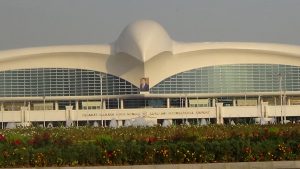
nCa Commentary
Ashgabat, 19 September 2016 (nCa) — The speech of President Berdymuhamedov at the opening ceremony of the Ashgabat International Airport on 17 September 2016 can be described as a policy statement, explaining the strategy of Turkmenistan in transport-transit sector.
In order to establish the context, let’s look at how the Dubai International Airport relates to the economy of Dubai.
The Dubai International Airport (DXB) is the world’s busiest airport by international traffic and sixth busiest in cargo traffic. In 2015, DXB handled 78 million passengers, 2.51 million tons of cargo and registered 403517 aircraft movements.
The airport is home base of Dubai’s Emirates and FlyDubai. It has three terminals with total capacity of 90 million passengers per annum. The recently opened termina 3 of DXB is the second largest building in the world by floor space, and largest airport terminal in the world. As of January 2016, there were 7700 weekly flights operated by 140 airlines to over 270 destinations.
DXB directly employs 90000 people and indirectly supports 400000 jobs. It contributes USD 26.7 billion to the economy, which is about 27% of the GDB of Dubai. About 21% of the people employed in Dubai work for the airport.
More than 50% of people passing through DXB are transit passengers.
By 2030, the aviation sector of Dubai would be contributing a whopping USD 88.1 billion to the revenues and will support 1.95 million jobs. This represents 44.7% of GDP and 35.1% of total employment.
With these facts in mind, let’s look at some important points made by President Berdymuhamedov in his speech.
The Turkmen president said, “The favourable location of Turkmenistan at the crossroads of the Eurasian continent holds great promise for the effectiveness of its transport potential in global development. Our policy is aimed at accelerating socio-economic development and the establishment of a broad regional and international cooperation in the interests of the world community. One of the priorities of this policy is to create an extensive modern transport and communication infrastructure.”
Referring to the days of the great Silk Road, when the territory of Turkmenistan was host to several important branches of the Silk Road, the Turkmen leader said, “Our logistics strategy is based on the principles of historicism.”
He said that Turkmenistan has the potential to become again the transcontinental bridge, providing the framework for economic partnership between Europe, Asia Pacific and South Asia. He connected the growing infrastructure network under the broad concept of North-South and East-West corridor with his vision to transform Turkmenistan into a intra- and inter-regional transport-transit hub.
Berdymuhamedov was confident that the airport will become “a major transit point in the continental and intercontinental air routes.”
The airport with its capacity to handle 17 million passengers annually – 14 million at the new terminal and 3 million at the existing terminal 2 – and cargo handling capacity of 200000 tons has the possibility to replicate or even surpass at its own scale the success of the Dubai International Airport.
Its two runways, both 3800 meters in length, can allow for landing and take-off of any passenger or cargo aircraft.
There are a few things that Turkmenistan must do to make sure that the newly opened Ashgabat International Airport named after Oguzkhan becomes the major transport-transit centre and a key contributor to the GDP of the country:
- The duty free shopping complex at the airport should be the best in the world, offering widest range of items at prices that are irresistible. If done properly, this along should serve as a powerful magnet to attract transit traffic from around the region.
- Turkmenistan should offer refueling at favourable prices to all the carriers using the Ashgabat airport as a transit destination. The country can easily afford it because of its own production of aviation fuel.
- The Turkmenistan Airlines should rapidly expand its network of destinations to make Ashgabat a real hub for travel.
- The country should allow its private sector to launch an airline, either wholly owned by the entrepreneurs from Turkmenistan or in partnership with some experienced carrier. And, try to make it a full service airline with fares comparable to a budget carrier. Smaller margin of profit but larger number of passengers makes good business sense in the long run, as we can see from the example of Qatar Airways. People want quality; give them quality.
- Efficiency should be the top priority. An airport free from bottlenecks, full of convenience, and courteous service at every step gives the feeling that passengers want to experience again and again.
- The carriers using Ashgabat as destination or transit point should be given soft tariff for landing-take-off and other services. Bolstering the bottom line of their balance sheets will be a winning argument for them.
- Ashgabat currently has the capacity to handle nine or ten major conventions/conferences simultaneously. In addition, Awaza, the national tourist zone of Turkmenistan at the Caspian coast, can take about 9000 guests. In off-season this capacity is under-utilized. Turkmenistan should advertize itself as a regional and global centre for conventions and conference where business can be combined with some health improvement services and a bit of tourism.
- The Olympic Village in Ashgabat is a first-class sports complex. With state of the art facilities, it will have a wide range of uses beyond the AIMAG 2017. Turkmenistan can host regional and ultra-regional competitions year round. These facilities can also be rented out as permanent training centres.
Making full use of the vast capacity of the new airport in Ashgabat is an exciting challenge because it carries the promise of becoming a key contributor to the GDP. It will take a few years to fine-tune the system but the possibilities are very real and solid. /// nCa